Look! Listen! and Learn Language!
Early Intervention Activities for Language Development
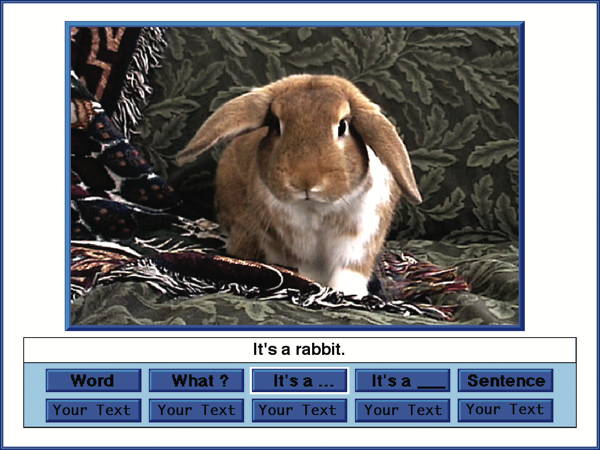
This game has eight interactive activities for children to learn language the fun way. Listen to animals; find those letters, shapes, and numbers; and talk, talk, talk!
Target Audience Appropriate for speech and language development for neurotypical children ages 3-8. Also appropriate for Children with Aphasia, Apraxia, Dysarthria, Autism, PDD, Down Syndrome, Cerebral Palsy, Language Delay.
WN25-2
$5.00
Look! Listen! and Learn Language!
by LocuTour Multimedia
Download now from Gumroad.
Look! Listen! and Learn Language! (Windows)
Information for Professionals
This CD is recommended for young children learning language, children with central auditory processing dysfunction, children with short term auditory memory dysfunction, and those with Autism, PDD, Down Syndrome, Language Delay, Aphasia, or Apraxia. This CD is also appropriate for hearing impaired individuals involved in an auditory habilitation or auditory rehabilitation program.
Games on this CD.
And the Little Duck Says, Quack, Quack
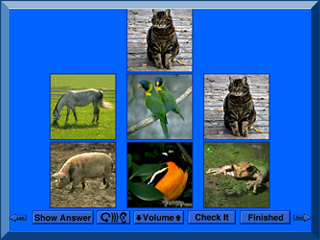
And the Little Duck Says, Quack Quack helps clients learn to identify the sounds that animals make. There are four levels with two, four, six, and eight animals to choose from.
Learning to listen to, then imitate, non-speech sounds can be an important first step in controlling vocalizations. Copying animal sounds is fun, and exaggerated movements of the lips, tongue, and jaw can encourage oral-motor imitation and manipulation of the articulators needed for speech. Auditory memory is enhanced by listening to the target sound then finding the matching sound in the field. Visual scanning and visual discrimination are enhanced by noticing similarities and differences between stimuli. Language expression can be encouraged through labeling pictures and creating phrases and sentences using the target stimuli.
Show Me
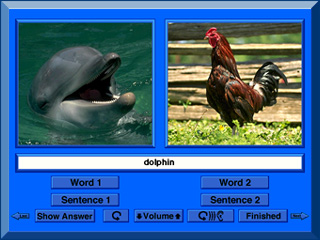
Show Me is a simple forced choice exercise using animals, verbs, and contrast words such as, over/under, happy/sad.
Responding to a direct request such as “Show Me...” is an important response. It indicates the receptive understanding of the command and the target word, and it shows the ability to demonstrate comprehension using an expressive motoric response. Expressive language can be encouraged by having the child name the target, use the word in a phrase, sentence, or short conversation.
Word Practice

Word Practice provides a transition from single words to simple phrases and sentences. Colorful photos are presented in three categories: verbs, contrasts, and animals.
Copying speech at the word, phrase and sentence levels can help with expressive language development. This activity extends the grammatical/syntactic concepts of the words from the Show Me game.
Let’s Talk About It

Let’s Talk About It provides multiple opportunities to answer different kinds of questions. Clients can record their imitative productions of phrases and sentences as well as their answers to the stimulus questions. There are sixty-six engaging scenes in eight categories.
Perseverative questioning is a speech characteristic of many autistic children and adults. Teaching multiple ways to question can be helpful, as can teaching them how to answer their own questions and to use statements. The pictures are grouped into eight question categories: Who, What, When, Where, Why, How, Which, and Other. A random mix of questions can be chosen by selecting the Mixed category.
ABC123

ABC123 allows clients to learn the alphabet, numbers from 1 to 20, and the 43 sounds used in English.
This task is designed to prepare the client for letter, number and word recognition tasks found on other LocuTour titles. This game establishes the “rules” for consonant and vowel sounds utilized in the other games.
Put Same with Same
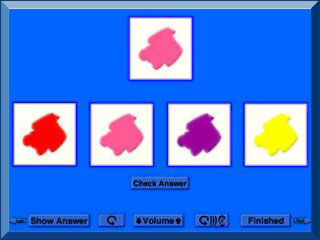
Put Same with Same is a color and shape matching game. There are seven levels of difficulty with eleven colors and eleven shapes.
Matching one item to another is an important pre-reading and pre-math skill.
Catch of the Day
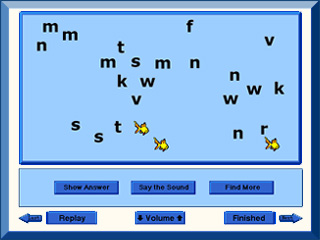
Catch of the Day is an auditory association/memory/visual scanning exercise. Look for three letter name, letter sound, number, or shape targets among the foils.
When children are first learning to make visual discriminations they will need practice discerning one item from another. The developmental hierarchy would be shapes, colors, numbers, consonants, and vowels. The auditory prompt of “Find...” allows the child to make an auditory connection to the visual stimuli.
Match Ups!
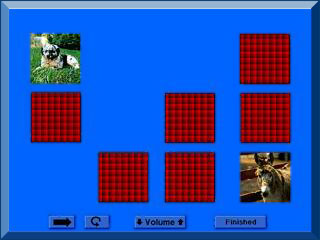
Look, Listen and Learn to remember shapes, letters, animals, and faces. There are 16 picture sets and 4 levels of difficulty (6, 12, 24, or 48 cards are displayed).
Match Ups! helps memory and association of words to pictures. Teaching strategies for remembering where a card has or has not been turned over helps with visual memory and working memory. This is a task of psychomotor performance relatively unaffected by intellectual ability, long-term memory functioning, or previous learning. It requires motor persistence, sustained visual attention and scanning, visuomotor coordination, and the ability to encode and recall the symbols. (Lezak 1985) It is designed to utilize Luria’s (1973) third functional unit- planning and verification of activity.
